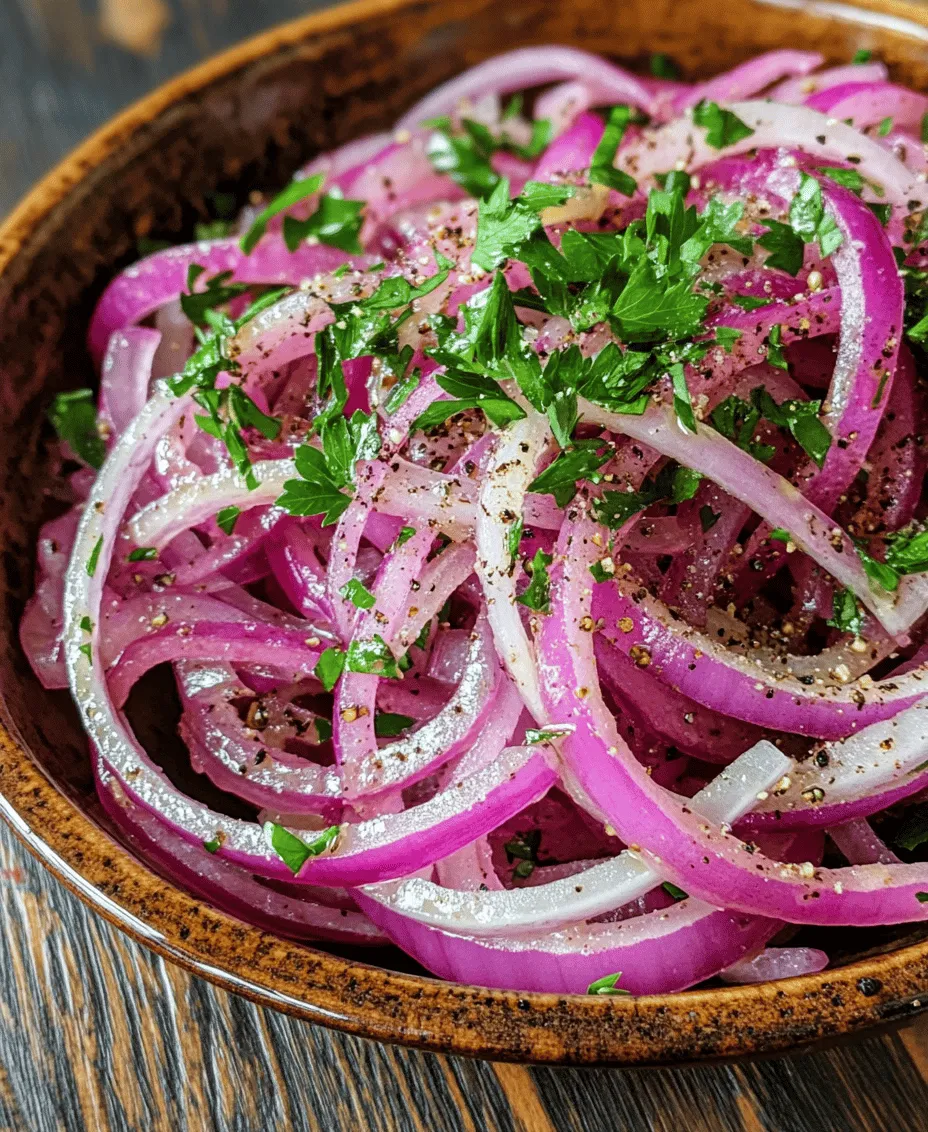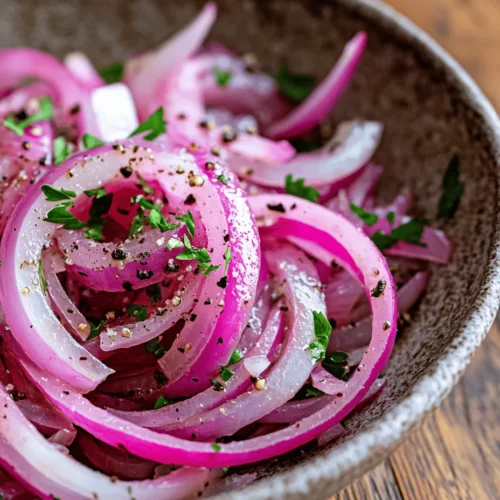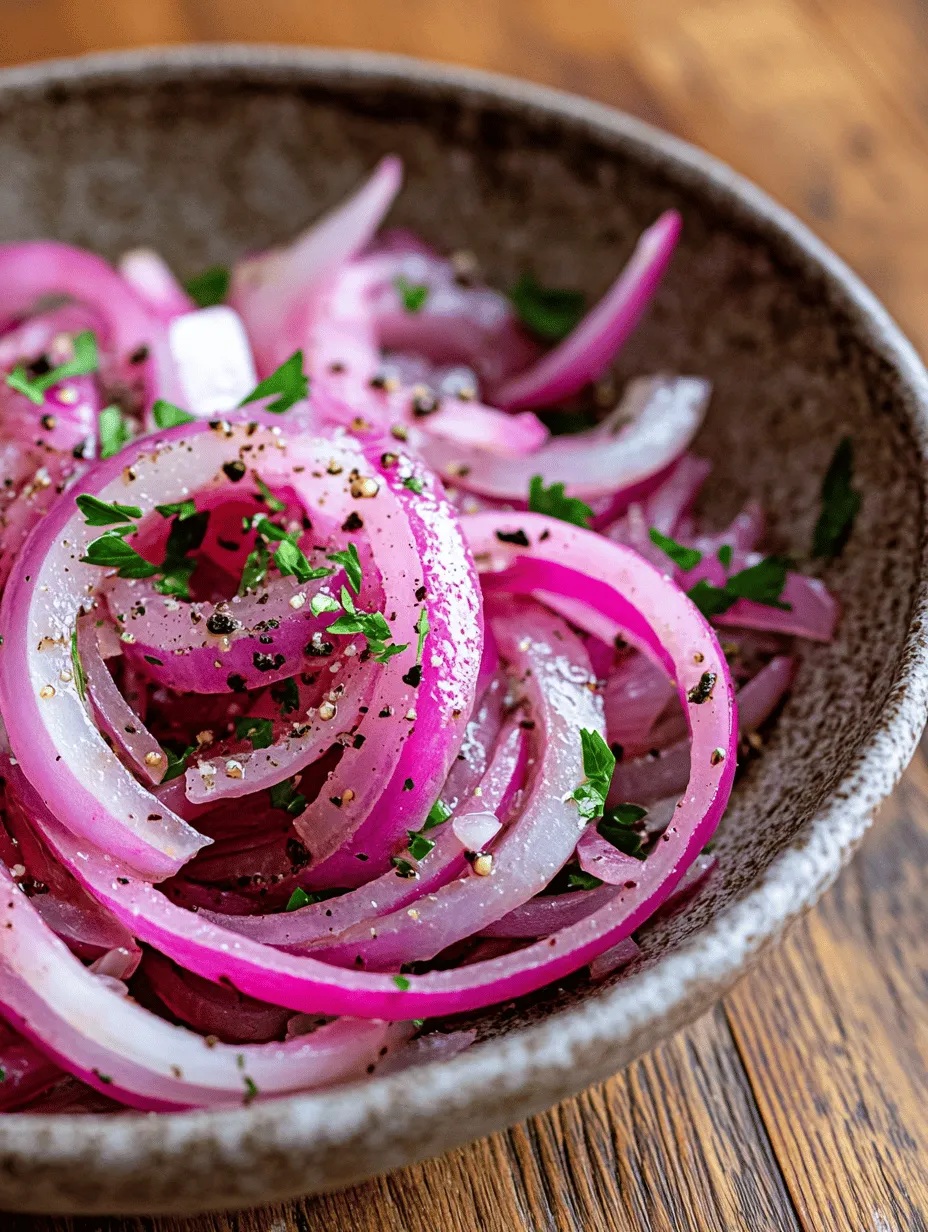Introduction to Tangy Sumac Onions
Tangy sumac onions are a vibrant and flavorful addition that can elevate a variety of dishes, from salads to grilled meats, and even as a unique topping for sandwiches. This simple yet sophisticated condiment showcases the ability to transform everyday ingredients into something gourmet. At the heart of this recipe is sumac, a spice that brings a distinct tartness, perfectly complementing the natural sweetness and crunch of red onions.
This dynamic duo not only enhances the flavor of your meals but also provides numerous health benefits, making tangy sumac onions an excellent choice for those looking to add a nutritious twist to their culinary creations. Whether you’re looking to spice up a weeknight dinner or impress guests at a gathering, this recipe is your ticket to culinary success.
As we delve into the preparation of tangy sumac onions, you’ll discover the importance of each ingredient and how they work together to create a deliciously tangy, aromatic dish that’s sure to delight your taste buds.
Understanding the Core Ingredients
To truly appreciate the dish, it’s essential to understand the significance of each ingredient used in tangy sumac onions. Each element plays a crucial role in not only flavor but also in enhancing the overall nutritional profile of this simple condiment.
Red Onions: Flavor and Health Benefits
Red onions are the star of this recipe, not just for their vibrant color but also for their distinct, slightly sweet flavor that sets them apart from their white and yellow counterparts. Their crisp texture and mild bite make them the perfect candidate for this dish.
From a nutritional standpoint, red onions pack a powerful punch. They are rich in antioxidants, particularly quercetin, which is known for its anti-inflammatory properties. This makes them not only a delicious addition to your meals but also a beneficial one for your overall health. Regular consumption of red onions may contribute to improved heart health, better digestion, and even enhanced immunity.
In addition to their health benefits, red onions add a beautiful pop of color to your dishes, making them visually appealing. Their natural sweetness balances the tartness of sumac, creating a harmonious blend that enhances the overall flavor profile of the dish.
Sumac: The Star Spice
Sumac is the spice that brings tangy sumac onions to life. Originating from the Middle East, this unique spice is made from the dried and ground berries of the sumac bush. Its flavor is often described as tart and lemony, making it a perfect complement to the sweetness of red onions.
Beyond its tangy taste, sumac is also celebrated for its health benefits. It is rich in antioxidants and has been traditionally used to aid digestion and improve overall health. The versatility of sumac extends beyond this recipe, as it can be used in a variety of dishes, from marinades to dressings, and even sprinkled over grilled vegetables or meats for an added punch of flavor.
In Middle Eastern cuisine, sumac is often used to season dishes, providing a unique acidity that enhances the overall taste. It is a staple in za’atar, a popular spice blend that is commonly used in Mediterranean cooking. Adding sumac to your pantry will undoubtedly expand your culinary horizons and allow you to experiment with flavors that are both exciting and delicious.
Olive Oil: Choosing the Right Kind
Olive oil is another key ingredient in tangy sumac onions, contributing both flavor and health benefits. When selecting olive oil for this recipe, opting for high-quality extra virgin olive oil is essential. This type of olive oil is derived from the first pressing of olives and is known for its rich flavor and numerous health benefits.
Extra virgin olive oil is packed with healthy monounsaturated fats, which are heart-healthy and can help lower bad cholesterol levels. It is also rich in antioxidants, making it an excellent choice for promoting overall health. The robust flavor of extra virgin olive oil enhances the onions’ natural sweetness while adding a silky texture to the dish.
When choosing olive oil, look for oils that are labeled as cold-pressed, as this method preserves the oil’s flavor and nutritional value. Additionally, consider the country of origin – oils from regions like Italy, Greece, and Spain are often regarded as some of the best in terms of quality and flavor.
Apple Cider Vinegar: More Than Just a Dressing
Apple cider vinegar is a crucial component in tangy sumac onions, playing a vital role in balancing the flavors of the dish. Known for its numerous health benefits, apple cider vinegar has gained popularity in recent years for its potential to aid digestion and regulate blood sugar levels.
In this recipe, apple cider vinegar adds a tangy note that complements the sumac and enhances the overall flavor profile. Its acidity works to soften the onions, making them more palatable and enjoyable. Additionally, apple cider vinegar is believed to have antimicrobial properties, contributing to improved gut health when consumed.
When selecting apple cider vinegar, choose organic, unfiltered varieties that contain the “mother,” a colony of beneficial bacteria that is formed during fermentation. This type of vinegar not only offers better flavor but also provides additional health benefits associated with its probiotic content.
Honey vs. Maple Syrup: Sweetening the Deal
Sweetness can be an essential component in balancing the tanginess of the sumac and apple cider vinegar. In this recipe, you have the option to use either honey or maple syrup, both of which provide unique flavor profiles and health benefits.
Honey is a natural sweetener that has been used for centuries, known for its antimicrobial properties and potential health benefits. Its distinct flavor can vary depending on the type of flowers from which the nectar is sourced, allowing for a range of tastes from floral to fruity. Honey pairs beautifully with the tangy notes of sumac, creating a harmonious blend of flavors.
On the other hand, maple syrup offers a rich, caramel-like sweetness that can also enhance the dish. It is a great alternative for those looking for a vegan option, as it is derived from the sap of maple trees. Maple syrup is less sweet than honey, allowing the other flavors to shine through while providing a natural sweetness.
When choosing between honey and maple syrup, consider dietary preferences and flavor preferences. Both options are excellent choices that can elevate your tangy sumac onions.
The Role of Sea Salt and Black Pepper in Flavor Enhancement
Seasoning is an essential step in any recipe, and tangy sumac onions are no exception. Sea salt and freshly cracked black pepper play critical roles in enhancing the flavors of this dish.
Sea salt is a natural seasoning that not only adds flavor but also helps to soften the onions. By drawing out moisture, sea salt encourages the onions to release their natural sugars, resulting in a sweeter and more flavorful condiment. Additionally, the minerals present in sea salt can provide health benefits, making it a superior choice compared to regular table salt.
Freshly cracked black pepper is another important component of this recipe. Its warm, slightly spicy flavor adds depth and complexity to the dish, balancing the tangy and sweet elements. Using freshly cracked pepper ensures that you get the maximum flavor and aroma, enhancing your overall culinary experience.
Preparation Steps for Tangy Sumac Onions
Now that we’ve explored the significance of each ingredient, it’s time to dive into the preparation steps for creating tangy sumac onions. The first step involves properly preparing the onions, which is crucial to achieving the best flavor and texture for this dish.
The Importance of Softening Onions
The process of softening onions is key to unlocking their natural sweetness and ensuring that they blend harmoniously with the other ingredients. To begin, thinly slice the red onions, taking care to create even pieces for a consistent texture. Once sliced, place the onions in a bowl and sprinkle them with sea salt.
The salt will draw out moisture from the onions, allowing them to soften and become more palatable. Let the onions sit for about 10-15 minutes before proceeding with the recipe. This step not only enhances the flavor but also helps to mellow the sharpness of the onions, making them perfect for use in salads, sandwiches, or as a standalone condiment.
By taking the time to soften the onions, you’re setting the stage for a delicious and tangy dish that will impress anyone lucky enough to enjoy it.

Softening Onions with Salt: Unlocking Texture and Flavor
One of the foundational steps in preparing Tangy Sumac Onions is softening the onions with salt. This technique is not only a matter of personal preference; it serves a crucial role in enhancing both the texture and the flavor of the onions. When onions are sprinkled with salt, they begin to release their natural moisture through a process called osmosis. As they soften, the salt penetrates the onion layers, drawing out excess water and breaking down the cell structure.
The result is a tender, less pungent onion that has a more balanced flavor profile. By softening the onions, you reduce their sharpness, allowing the tangy and zesty notes from the sumac and vinegar to shine through. This is particularly important in a dish like Tangy Sumac Onions, where the goal is to achieve a harmonious blend of flavors. The softened onions also absorb the dressing more effectively, ensuring that each bite is infused with the delightful combination of acidity, sweetness, and umami.
Creating the Dressing: A Balancing Act
The dressing for Tangy Sumac Onions is a key element that defines the dish’s overall taste. It requires a careful balance between three primary flavor components: acidity, sweetness, and umami. To create a well-rounded dressing, begin by combining high-quality vinegar—such as red wine vinegar or apple cider vinegar—with a touch of honey or maple syrup. This sweetness helps to counterbalance the sharpness of the vinegar and the tangy notes of sumac.
Sumac itself brings a unique citrusy flavor that adds brightness to the dish. When making the dressing, it’s essential to taste and adjust each component. Consider starting with a base ratio of two parts vinegar to one part sweetener, then gradually incorporate sumac while tasting along the way. This iterative approach ensures that the dressing complements the onions without overpowering them. Once the desired balance is achieved, whisk the ingredients together until fully combined, creating a smooth and flavorful dressing that will elevate your onions.
Marination: The Key to Flavor Development
Marination is an essential step in the preparation of Tangy Sumac Onions, as it allows the flavors to meld and intensify. During marination, the onions soak in the dressing, absorbing the tangy, sweet, and umami elements. This not only enhances the onions’ flavor but also transforms their texture, making them more palatable and enjoyable.
For optimal flavor development, a marination time of at least 30 minutes is recommended. However, if you have the luxury of time, consider letting the onions marinate for a few hours or even overnight in the refrigerator. Longer marination times lead to more pronounced flavors, as the onions will continue to absorb the dressing and become more tender. Additionally, variations in marination can introduce new flavor dimensions; try adding fresh herbs such as parsley or cilantro for an aromatic twist, or include a pinch of chili flakes for a hint of heat.
Serving Suggestions for Tangy Sumac Onions
As a Condiment
Tangy Sumac Onions make an exceptional condiment that can elevate a variety of dishes. When served alongside grilled meats, fish, or vegetarian options, the onions provide a refreshing contrast that cuts through richness. Their acidity brightens up hearty dishes, making them an ideal accompaniment to kebabs or roasted vegetables. Simply spoon the marinated onions over the protein of your choice, and let the flavors mingle.
In Salads
Incorporating Tangy Sumac Onions into salads can introduce a delightful zing. Their zesty flavor profile can liven up classic salads such as mixed greens, quinoa, or grain bowls. For a Mediterranean twist, combine the onions with cucumbers, tomatoes, and feta cheese, drizzling everything with olive oil and lemon juice. The sumac onions add a unique burst of flavor that transforms a simple salad into a standout dish.
On Sandwiches and Wraps
The tangy flavor of these onions can also enhance sandwiches and wraps in significant ways. Spread creamy hummus or tzatziki on your wrap, then layer in fresh veggies, grilled chicken, or falafel, finishing with a generous portion of Tangy Sumac Onions. The contrast of textures and flavors creates a satisfying meal that is both refreshing and fulfilling.
In Middle Eastern Dishes
In traditional Middle Eastern cuisine, Tangy Sumac Onions find a natural home. They are an excellent addition to dishes like falafel or shawarma, where their acidity complements the rich flavors of seasoned meats and legumes. Simply serve the onions alongside your favorite Middle Eastern dish, letting diners customize their plates for an authentic experience. The onions can also be used in pita sandwiches, elevating the overall flavor profile with their bright and tangy notes.
Nutritional Benefits of Tangy Sumac Onions
Low-Calorie and Nutrient-Dense
Tangy Sumac Onions are not only delicious but also a nutritious addition to your diet. Onions are low in calories while being rich in vitamins and minerals, including vitamin C, vitamin B6, and manganese. Combined with the health benefits of vinegar and sumac, this dish becomes an excellent choice for those looking to enhance their meals without adding excessive calories.
Rich in Antioxidants
The ingredients in Tangy Sumac Onions are also packed with antioxidants, which play a vital role in promoting overall health. Onions are known for their flavonoid content, which has been linked to reduced inflammation and improved heart health. Sumac, on the other hand, is recognized for its high levels of antioxidants, which can help combat oxidative stress in the body. Including this dish in your meals contributes to a well-rounded, health-conscious diet.
Promoting Digestive Health
The combination of vinegar and onions in Tangy Sumac Onions can aid digestion. Vinegar is known to support gut health by promoting the growth of beneficial bacteria, while onions are a source of prebiotics that feed these good bacteria. This synergy can lead to improved digestive function and overall gut well-being.
Conclusion: Embracing the Versatility of Tangy Sumac Onions
Tangy Sumac Onions are a delightful and healthy addition to a variety of meals, offering a unique blend of flavors that can enhance any dish. Their versatility allows them to shine not just as a condiment but in salads, wraps, and traditional Middle Eastern recipes. The health benefits of the ingredients make this dish a smart choice for those looking to incorporate more nutritious options into their diets.
Preparing Tangy Sumac Onions is a simple yet rewarding process that allows you to explore the unique flavor combinations it brings to your cooking. By experimenting with marination times and serving styles, you can discover the perfect balance that suits your palate. We encourage you to try this recipe and embrace the vibrant, tangy flavors of sumac onions in your everyday meals. You may just find a new favorite to add to your culinary repertoire.



